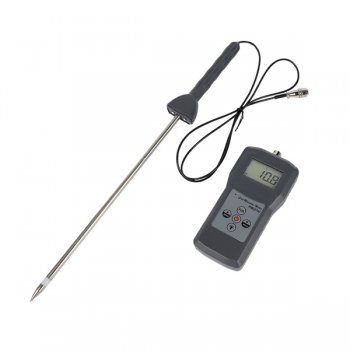How to Use a Moisture Meter to Discover Concealed Water Damages in Your Building
How to Use a Moisture Meter to Discover Concealed Water Damages in Your Building
Blog Article
Explore the World of Moisture Meters: Everything You Required to Know
In the world of dampness meters lies a globe of precision and usefulness that commonly goes unnoticed. Comprehending how moisture meters run, the various types readily available, and their diverse usages can shed light on their relevance in ensuring top quality and efficiency.
Exactly How Moisture Meters Work
Moisture meters run by measuring the electrical conductivity or capacitance of materials to identify the wetness content existing. These meters are important devices throughout various markets, consisting of construction, agriculture, and woodworking. By making use of various methods such as pin-type or pinless technology, wetness meters supply precise analyses that aid specialists make informed decisions.
Pin-type dampness meters function by putting the sharp pins right into the product being checked. On the other hand, pinless wetness meters utilize electromagnetic signals to scan a larger area without triggering any type of damages to the material's surface.
Regardless of the method used, moisture meters play a vital duty in preventing issues such as mold growth, structural damage, or item issues brought on by excess dampness. Recognizing how these meters job is vital for making sure the high quality and stability of products in numerous applications.
Kinds of Moisture Meters
Offered the critical role moisture meters play in various markets, it is important to understand the different types readily available to specialists for properly analyzing dampness levels - Moisture Meter. There are largely 2 primary types of wetness meters: pinless and pin-type wetness meters

On the various other hand, pinless dampness meters make use of electro-magnetic sensing unit plates to scan a bigger location of the product without triggering any damages. This type is suitable for rapidly scanning big locations and is typically used for flooring, wall surfaces, and ceilings. Pinless meters are hassle-free for taking analyses on finished surfaces without leaving any type of visible marks.
Both sorts of dampness meters have their advantages and are selected based upon the specific demands of the work at hand. Comprehending the distinctions between these types is critical for professionals to make precise dampness assessments.
Applications Across Industries
With varied capabilities, moisture meters find extensive application throughout numerous industries, helping experts in making certain optimal conditions for frameworks and products. In the farming field, moisture meters are indispensable for establishing the dampness content in grains, seeds, and hay, ensuring high quality control and stopping mold and mildew development. Building and construction specialists depend on dampness meters to analyze the dampness degrees in structure products like drywall, concrete, and wood, which is important for preserving architectural stability and stopping problems like rot or mold and mildew. The flooring market uses wetness meters to determine the moisture content in subfloors before installing various floor treatments, protecting against costly problems due to excess dampness. In the food market, wetness meters are utilized to keep track of and control moisture levels in items such as grains, nuts, and dried out fruits to preserve freshness and quality. Additionally, moisture meters play an essential function in the repair and damage control sector by assisting professionals recognize and resolve water damages in buildings promptly. Throughout these diverse sectors, wetness meters are essential tools for ensuring the top quality, safety, and long life of different products and products.
Tips for Utilizing Wetness Meters
Utilize the wetness meter's calibration setups to make sure precise readings when measuring the moisture web content in numerous products. Furthermore, make sure the meter is set to the appropriate moisture range for the product you are gauging to acquire the most accurate results.
When using a pin-type moisture meter, put the pins to the ideal deepness suggested for the material being examined. This makes certain that the dampness readings are taken from the correct deepness within the material, offering a more exact depiction of its wetness content. For pinless moisture meters, bear in mind to preserve proper call with the product's surface to obtain trusted analyses.
Frequently check and replace the batteries in your moisture meter to protect against incorrect analyses due to reduced power. When not in usage to prolong its life expectancy and keep its accuracy, Shop the meter in a completely dry and risk-free place. By complying with these pointers, you can maximize the efficiency of your dampness meter and obtain exact moisture content dimensions throughout different materials.
Upkeep and Calibration
To guarantee the accuracy these details of moisture content measurements, normal upkeep and calibration of the dampness meter are necessary actions in its appropriate functioning. Calibration adjusts the moisture meter to make certain that it gives regular and trustworthy results.
Calibration should be performed occasionally, specifically if the wetness meter is utilized frequently or in critical applications where specific dimensions are required. Many dampness meters include calibration tools or can be adjusted by expert services. Moisture Meter. It is advised to keep a log of calibration days and results to track the efficiency of the wetness meter over time. By adjusting the moisture and keeping meter on a regular basis, individuals can rely on the precision of the moisture web content measurements gotten.
Conclusion

In verdict, dampness meters play an essential function in numerous industries by precisely measuring the moisture material of products. Understanding how these gadgets function, the various types offered, and appropriate upkeep and calibration are crucial for obtaining reputable results. Whether in agriculture, building, or production, the usage of moisture meters assists guarantee high quality control and effectiveness in procedures.

In final thought, moisture meters play an essential role in numerous markets by accurately measuring the dampness material of materials.
Report this page